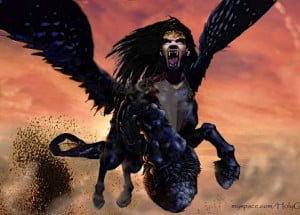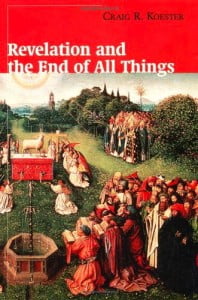Rev 8 and 9—the hardest passages to preach on?
 I've only been writing some Bible-reading notes for Scripture Union (due out side by side year) on the offset half of Revelation. It has been quite a claiming to writing something attainable and devotional on this complex text!
I've only been writing some Bible-reading notes for Scripture Union (due out side by side year) on the offset half of Revelation. It has been quite a claiming to writing something attainable and devotional on this complex text!
In fact, the first few capacity were not too bad. In that location is much to say about the opening section, and the vision of Jesus it presents. The messages (not 'letters'!) to the seven congregations (not 'churches'!) besides accept plenty of scope for devotional reflection—perhaps more hands than whatsoever other part of the book as a whole (excepting ch 21), which is why I estimate at that place is so much written on them. The visions of worship in capacity iv and 5 are also relatively easy to appoint with, though perhaps not in the way many people call back—the blending of imagery from the OT with contemporary images from Emperor 'worship' offering a specific challenge to u.s.a.. The saints under the chantry in chapter 6 offer a mode into this section, and chapter 7 gives an extended reflection on what information technology means to exist the people of God—disciplined as an army, suffering in combat, but praising God non so much for what God has done or is doing merely for what God volition practise. (Warning: book coming on this one twenty-four hour period!).
And so nosotros reach capacity 8 and 9. What do you do, devotionally, with hideous, war-mongering locusts with women'due south hair and homo teeth, clanking and rattling their iron breastplates? How will these help y'all to alive for Jesus today? (A clue: this is not a futuristic vision of attack helicopters, as some would have y'all believe.)
I accept been helped past going back to a number of commentaries—Caird, Boxall, Beale, Mounce—and I have previously spent quite some time dwelling in some of these passages. But I was peculiarly helped by what I would call the critically-informed theological reading in Craig Koester'sRevelation and the Finish of All Things. What is interesting near this book is that it includes some introductory comments, simply and so goes on to offering a reading of each section of the text—non in a verse-past-verse format you lot would detect in a commentary, but looking at the problems, the flow of the text, and how we might make some sense of information technology. Koester besides has a great way of writing.
The opening observations most the structure of these ii chapters caught my eye:
With each successive scene, disaster strikes globe, sea, and sky, until the demonic hordes of locusts and cavalry torment humanity amid clouds of fire, smoke, and sulfur (8.7–9.21). The cycle is all the more ominous because the destruction unfolds in a relentlessly measured mode. the effect is something like an orchestral performance in which the strings scrape dissonant chords while woodwinds shriek, trumpets blair, and cymbols crash in what seems to exist wild discord—except that all the players motility to a steady beat that is set past the conductor's hand: i, two, 3, four… (p 93)
I love this metaphor, and it captures well the theological tension in the text reflection past the juxtaposition of literary construction and symbolic anarchy. God is in command—and nevertheless, within this, the chaotic forces of evil announced to be shaping the world.
In relation to chapter 9, Koester highlights really well the feature of the 'macro-structure' of Revelation: the alternation betwixt the heavenly scenes of peace and society, and the earthly scenes of chaos and destruction. (This is the principal reason why the lectionary option of passages does not work; information technology picks out mostly one kind of scene, the heavenly, and the significance of this is lost when such scenes are no longer contrasted with their earthly counterpoints.)
Revelation depicts life under two forms of rule. The vision of the heavenly throne room in Revelation iv–5 showed a rightly ordered universe, in which creatures offered praise to their Creator and to the Lamb, who are worthy of ability. But in Revelation 9, grotesque figures create a demonic parody of the created society, showing what conditions are like under the lordship of the king of the underworld, whose names Abaddon and Apollyon mean Destruction and Destroyer (9:11). Each of the winged creatures that attended the Creator had its ain distinct confront, ane with a human being face and some other with the face ofa lion, etc.; but the winged beings that accompany the Destroyer have a hideous collage of traits: lions' teeth protrude from man faces, while in front their chests are plated with iron and in back they have tails like scorpions. Where the elders in the heavenly throne room bandage their crowns before God as they raised a harmonious song of praise (4:10-1 one), the demonic locusts go on to wearable crowns on their heads as they raise a pounding and clanking roar, like chariots going into battle.
The judgment depicted hither is not directly divine penalty, but a revelation of what it would mean for God to manus over the world to other powers…(p 100)
 Koester here nicely draws out the way that, in Revelation, literary structure is a key bearer of meaning. And his reading is theological, in the sense that this terminal phrase helped me make connections with Paul'due south language of 'handing over' in Romans 1.24 and elsewhere. He also highlights the innuendo to OT images (of locusts, plagues and the like), and would want to add in echoes of things in the beginning-century world, such as the 'blazing mountain' reminding readers of the eruption of Vesuvius.
Koester here nicely draws out the way that, in Revelation, literary structure is a key bearer of meaning. And his reading is theological, in the sense that this terminal phrase helped me make connections with Paul'due south language of 'handing over' in Romans 1.24 and elsewhere. He also highlights the innuendo to OT images (of locusts, plagues and the like), and would want to add in echoes of things in the beginning-century world, such as the 'blazing mountain' reminding readers of the eruption of Vesuvius.
This does not solve all the problems and challenges of Revelation, especially with the violence of its imagery. But it reminded me of the depiction of evil in Lord of the Rings past J R R Tolkein. Interestingly, Tolkein'south vision was less an indulgence in fantasy as an expression of the reality of evil that he had encountered in the death and devastation of the Western Front in the First World War.
My notes are coming out as part of Run into with God for May 2015; you can society these and others from the Scripture Wedlock website.
Yous might too exist helped past my Grove booklet onHow to Read the Book of Revelation.
And Koester has as well been fundamental in developing Luther Seminary's complimentary resource Enter The Bible. It is a great way of getting a good overview of the whole Bible, with caption, comment, and some brusque video clips.
Much of my work is done on a freelance basis. If you lot have valued this post, would y'all consideraltruistic £i.20 a month to back up the production of this blog?
If yous enjoyed this, exercise share information technology on social media (Facebook or Twitter) using the buttons on the left. Follow me on Twitter @psephizo. Similar my page on Facebook.
Much of my work is done on a freelance basis. If y'all accept valued this post, you lot can make a single or repeat donation through PayPal:
Comments policy: Good comments that engage with the content of the post, and share in respectful contend, tin add real value. Seek kickoff to understand, then to be understood. Brand the most charitable construal of the views of others and seek to learn from their perspectives. Don't view contend every bit a conflict to win; accost the argument rather than tackling the person.
Source: https://www.psephizo.com/preaching-2/rev-8-and-9-the-hardest-passages-to-preach-on/
Postar um comentário for "Rev 8 and 9—the hardest passages to preach on?"